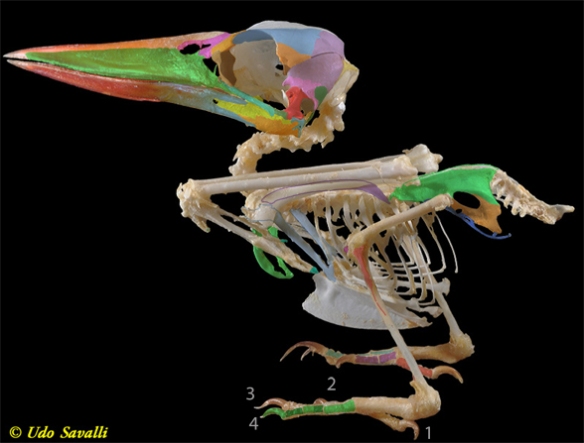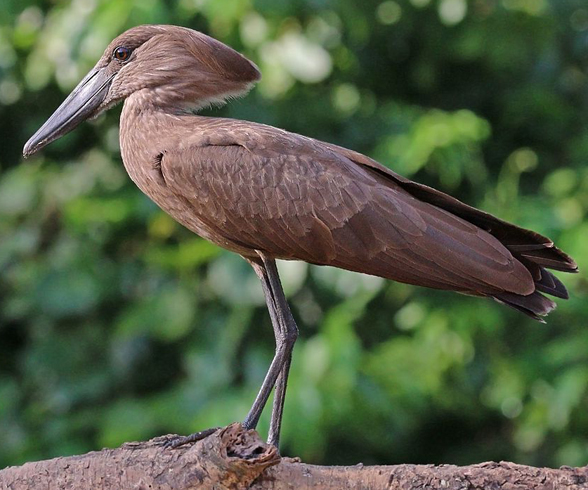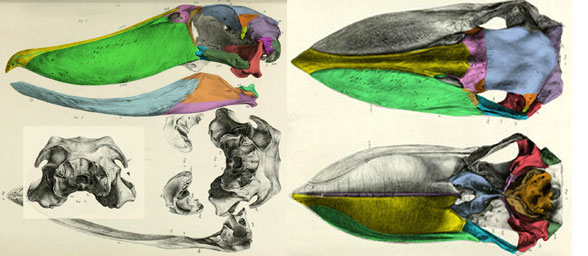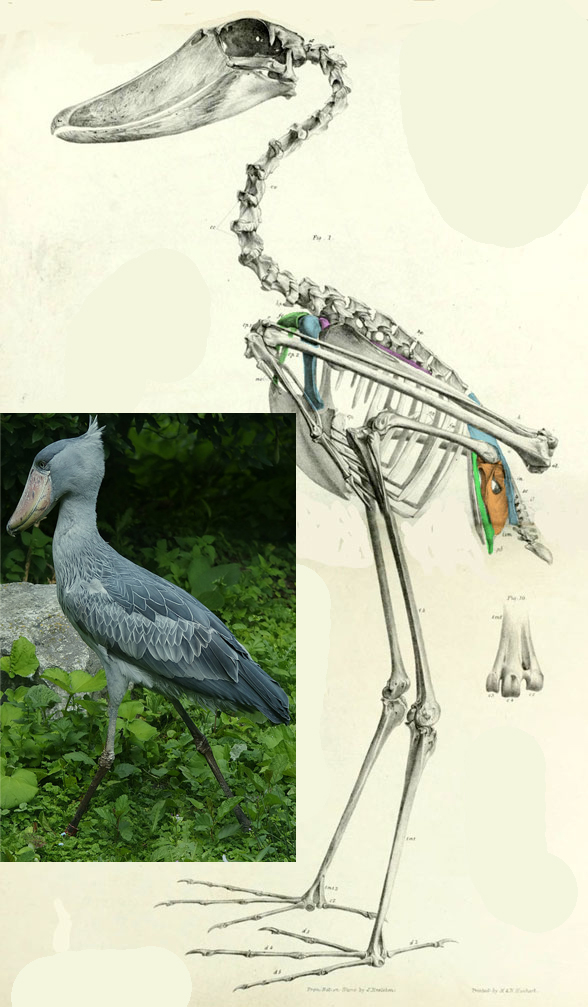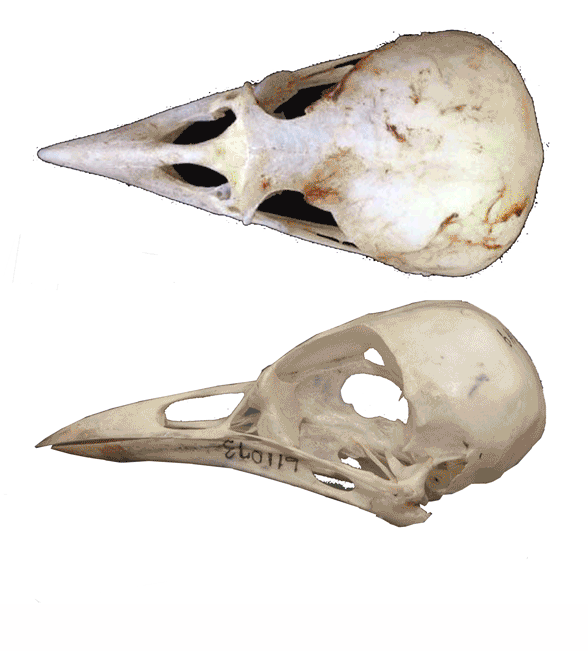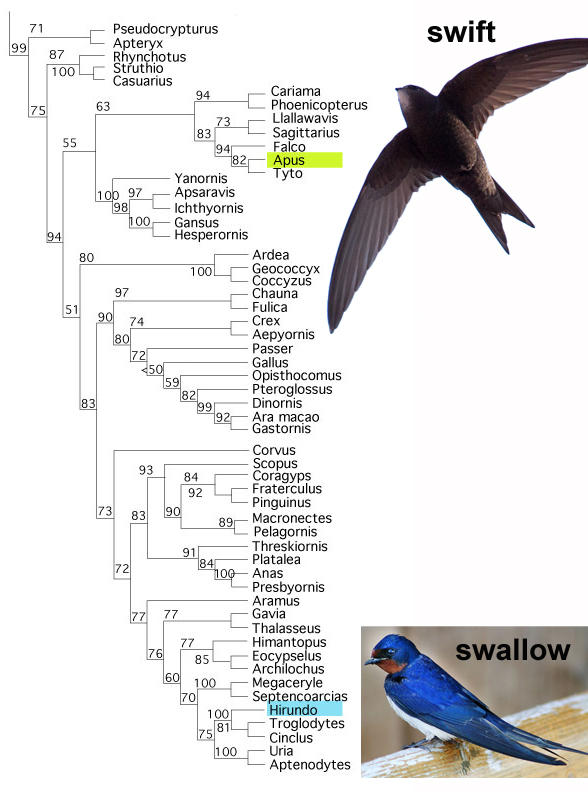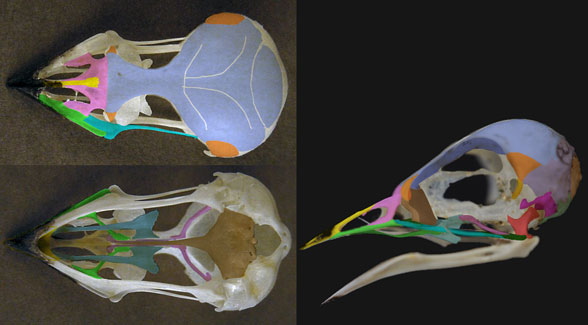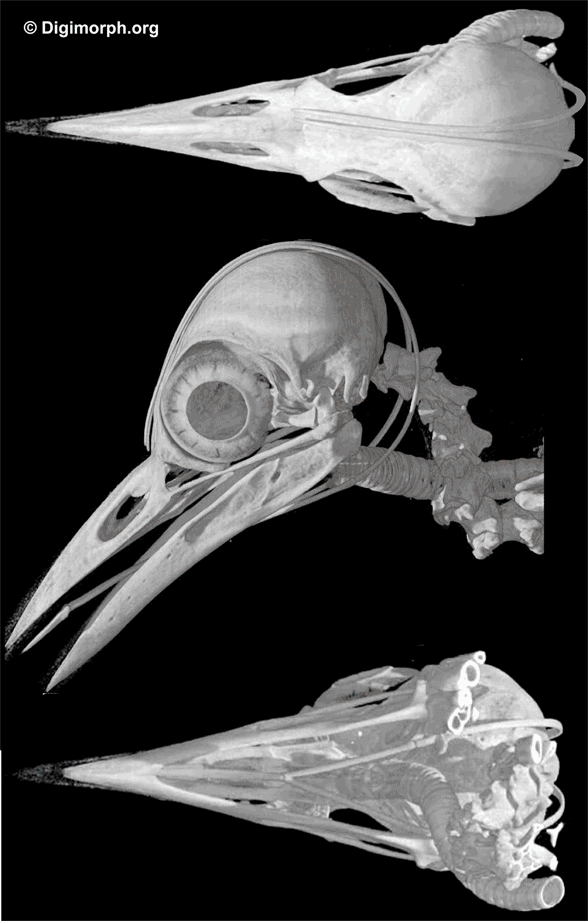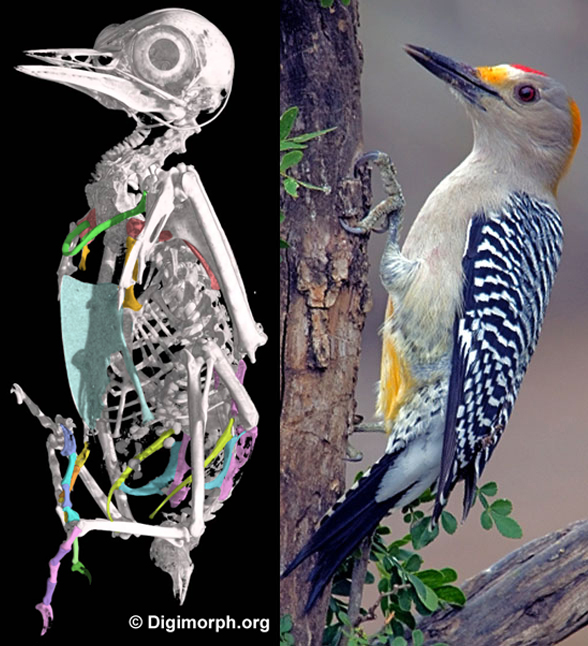Updated January 9, 2023.
But should have been updated earlier. Since this original posting more taxa have been added and a new understanding of dodo relationships moves it over to the pigeon clade.
This is what happens
when you add taxa to the mix. The large reptile tree (LRT, 1105 taxa) does what it does without tradition, taxon exclusion, bias or tribute to any overlord professor. Dodos and solitaires (Figs. 1, 3, 5-7) are not pigeons (Fig. 2) in the LRT (Fig. 8). Given the present list of taxa dodos nest as flightless vultures, a relationship proposed over a hundred years ago by Owen (1846), but abandoned within two years by Strickland and Mehlville (1848) in favor of the earlier pigeon hypothesis by Reinhart (1842). And that has been gospel ever since.
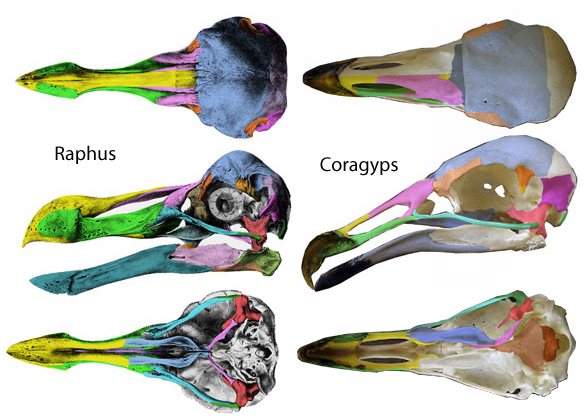
Figure 1. The dodo, Raphus, compared to the New World vulture, Coragyps. These two nest together apart from the pigeons in figure 1.
Current thinking (going back to Reinhart 1842)
(Wikipedia dodo page) nests the dodo (genus: Raphus, Fig. 1) with the nicobar pigeon (genus: Caloenas, Fig. 2). If you’ve ever wondered about this, I had the same giant question mark over my head, too. Here, finally, the dodo gets tested in a large gamut taxon list and another long-standing paradigm falls by the wayside.

Figure 2. Two pigeon skulls, Caloenas and Columba. These taxa nest together apart from vultures (Fig. 8) and the dodo, Raphus (figure 2). Even the palate is different here. By convergence, and beside the point, these pigeons look more like the vulture, Coragyps, and less like the dodo, Raphus (Fig. 1).
The LRT
nests the dodo, Raphus, with the New World vulture, Coragyps (Fig. 1). So, the dodo is a flightless vulture, not a pigeon. Both are derived from soaring seabirds like Macronectes. This addition of related taxa pushes the puffin, Fratercula, and the auk, Pinguinus, off to the side, as sisters to the Coragyps/Raphus clade. They also had a common ancestor among long-ranging sea birds,
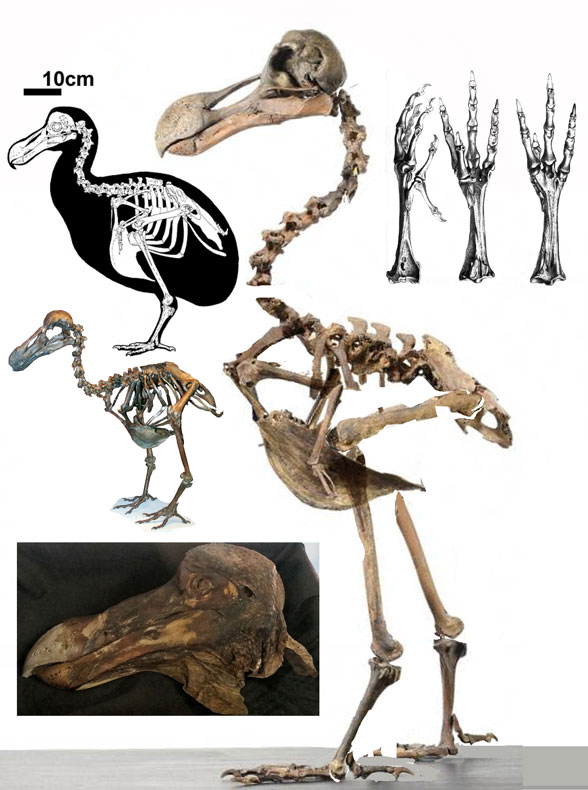
Figure 3. Dodo (Raphus) skeletal data.
According to Wikipedia:
“The dodo was variously declared a small ostrich, a rail, an albatross, or a vulture, by early scientists. In 1842, Danish zoologist Johannes Theodor Reinhardt proposed that dodos were ground pigeons, based on studies of a dodo skull he had discovered in the collection of the Natural History Museum of Denmark. This view was met with ridicule, but was later supported by English naturalists Hugh Edwin Strickland and Alexander Gordon Melville in their 1848 monograph The Dodo and Its Kindred, which attempted to separate myth from reality. After dissecting the preserved head and foot of the specimen at the Oxford University Museum and comparing it with the few remains then available of the extinct Rodrigues solitaire (Pezophaps solitaria) they concluded that the two were closely related. Strickland stated that although not identical, these birds shared many distinguishing features of the leg bones, otherwise known only in pigeons.”
“Strickland and Melville pointed to the very short keratinous portion of the beak, with its long, slender, naked basal part.”
A trait shared with Coragyps by convergence.
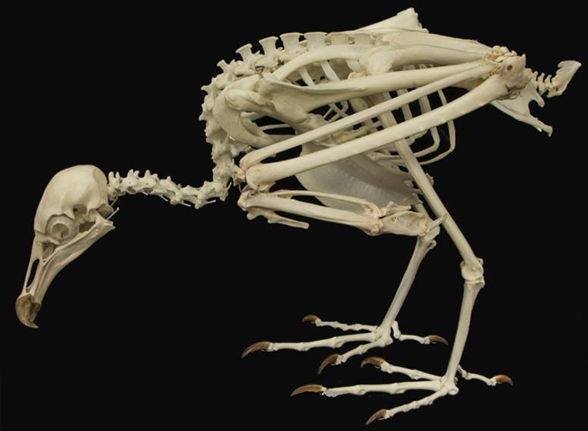
Figure 4. When vultures drift north and start finding fish attractive they evolve into auks and puffins.
“Other pigeons also have bare skin around their eyes, almost reaching their beak, as in dodos.”
As in Coragyps.
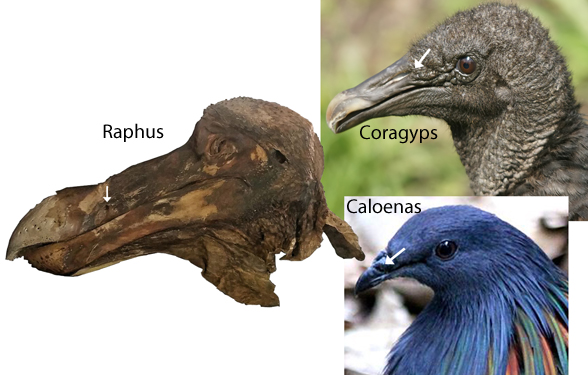
Figure 5. Raphus skull compared to Coragyps, a vulture, and Caloenas, a pigeon. White arrow points to nostril.
“The forehead was high in relation to the beak, and the nostril was located low on the middle of the beak and surrounded by skin, a combination of features shared only with pigeons.”
And vultures.
“The legs of the dodo were generally more similar to those of terrestrial pigeons than of other birds, both in their scales and in their skeletal features.”
I can’t comment on this with available data, other than to say the description is too general and many bird legs are similar in structure, inside and out.
“Depictions of the large crop hinted at a relationship with pigeons, in which this feature is more developed than in other birds.”
Also found in vultures.
“Pigeons generally have very small clutches, and the dodo is said to have laid a single egg.”
Coragyps lays from one to three eggs.
“Like pigeons, the dodo lacked the vomer and septum of the nostrils, and it shared details in the mandible, the zygomatic bone, the palate, and the hallux.”
You can see through both nares in Coragyps, too. The rest of this description is too generalized to comment on, other than to say the LRT recovers more dodo traits shared with the vulture, Coragyps than with the pigeon, Colaenas.
“The dodo differed from other pigeons mainly in the small size of the wings and the large size of the beak in proportion to the rest of the cranium.”
Same with Coragyps.
Not too many skeletal traits
listed by these authors. The LRT employs only skeletal traits. Not sure why vultures were excluded from dodo cladograms. And if they were not excluded, one has to wonder why dodos did not nest with Old World vultures. The long list of synapomorphies easily overwhelms any list of pigeon traits.
Raphus cucullatus (Linnaeus 1758; recently extinct; 1m tall) is the flightless dodo, endemic to the island of Maritius, east of Madagascar. Traditionally the closest living relative is the Nicobar pigeon, Caloenas. Here Raphus nests with Pezohaps and Coragyps, a New World vuluture.
The dodo has a less famous flightless relative
more closely related to it than to Coragyps. Meet Pezophaps solitaire (Fig. 6), the flightless solitaire, from the island of Rodrigues, east of Madagascar. It was also recently discovered and recently decimated by humans.

Figure 6. Swan-sized, Pezophaps, the solitaire, is the closest dodo relative. It is likewise closer to New World vultures than to African pigeons.
Pezophaps solitaria (Gmelin 1789; recently extinct; 70cm tall) is the flightless solitaire, from the island of Rodrigues, east of Madagascar. Here it nests with the dodo, Raphus, and both are related to the New World vulture, Coragyps.

Figure 7. Pezophaps skull. This is a very robust skull for any bird or any theropod dinosaur.
Coragyps atratus (LaMout 1853; 56 cm in length, 1.5m wingspread) is the extant black vulture and a sister to the giant petrel. Note the similar premaxilla. As in Raphus, the dodo, the head and neck lack feathers.
Unlike the flightless ratites
these flightless birds kept a deep sternum, despite having tiny wings.
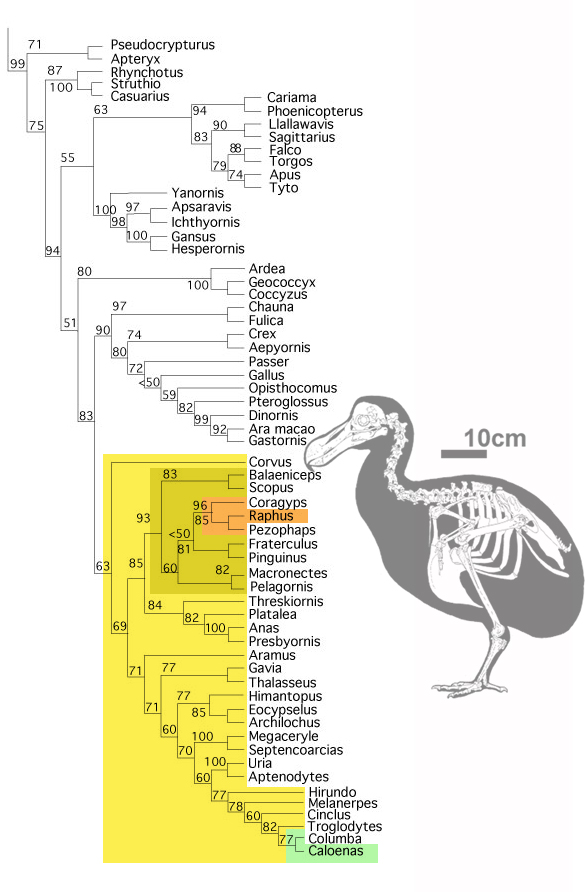
Figure 8. Subset of the LRT focusing on birds. Here Raphus, the dodo, nests with the New World vulture, Coragyps (in orange), not the pigeon, Caloenas (in green).
Oddly, if you’ve noticed…
dodos and solitaires both lived east of Madagascar, in the Old World. They are not closely related to Old World vultures like, Torgos. Rather, dodos and solitaires are related to New World vultures. How can that be? All hypotheses and speculations are welcome. IMHO we’re going to find a long-ranging, soaring seabird that was the last common ancestor of both dodos and New World vultures. Or we’ll find some New World vulture fossils in the Old World, out-competed or diseased out of existence, except on those tiny islands East of Madagascar.
Size matters, sometimes.
Both the dodo and the solitaire are closer in size to soaring sea birds and vultures than to pigeons. I think the historical confusion arose because, for reasons unknown, pigeons do indeed share several traits with New World vultures (including dodos) by convergence (Figs. 1, 2).
At this point, I look for further citations
Meuer et al. 2014 report in an abstract that only one complete dodo skeleton is known from a single individual. Others are chimeric combinations of incomplete specimens. They report, “Dodo cranial morphology is characterized by a lengthening and heightening of the maxilla, a concomitant antero-posterior compression of the cranium and a dorsally expanded frontal region. There is no ossified nasal septum, and both specimens lack an ossified vomer. Although the orbital region forms a large part of the cranium, it is reduced in size relative to extant Columbiformes. The occipital region is flat, wide and oriented vertically. The foramen magnum and the occipital condyle are located in a posterior position on the skull. This arrangement is similar to that of the closely related Solitaire of Rodriguez, Pezophaps solitaria, but differs from extant Columbiformes, including the dodo’s closest living relative, the Nicobar Pigeon (Caloenas nicobarica).
See how hey bought into the tradition without testing. Now look at all the differences these authors find between pigeons (columbids) and the dodo:
“In these columbids, the occipital region is more rounded and both the foramen magnum and occipital condyle are located ventrally. The fossa temporal is of the dodo is deep and narrow, and the quadratum is X-shaped. Both the mandible and cranium are only gently curved dorso-ventrally. The mandibular rami are high and narrow, and contain only a single mandibular foramen. The medial mandibular process is large and triangular, and together with articulatory processes on the basitemporal plate, argues for a secondary articulation of the mandible with the basitemporal plate. Our study of the Thirioux specimens highlights the dodo’s peculiar cranial morphology, which likely evolved in response to a more demanding and specialized lifestyle and feeding mechanism than previously appreciated.”
Shapiro et al. 2002 report, “The evolutionary history of the dodo is very poorly understood.” They phylogenetically tested the dodo only against Pezophaps and 35 pigeons and doves… and they used DNA.
Switek 2011 reports, “First-hand accounts of the birds agreed that they sported plumage that was black to grey in color,”
Hume 2006 reports, “More has been written about the dodo Raphus cucullatus of Mauritius than any other bird. Many conclusions based on the available data are problematic.”
Strckland and Mehlville 1848, credit Owen 1846 with relating the dodo to the raptorial birds and Reinhart 1842 for noting the pigeon affinities with the tubular naris (Fig. 5).
Naish 2014 reviewed a book by Parish 2012. “Today it’s well known and near-universally accepted that dodos and solitaires are pigeons, deeply nested within Columbidae. Historically, however, these birds have been considered related to, or members of, ratites, gamebirds, swans, penguins, vultures, waders, and rails. Parish reviews all of these, often fanciful, suggestions (and others), using the assorted family trees and other diagrams produced by the respective authors.”
I did not have access to this book prior to posting this blog. But I have seen the evidence and I understand and attempted to show that dodos and solitaires nest with New World vultures rather than pigeons in the LRT. As readers know, I am not adverse to testing long-held paradigms and purported clades. This is just one more heresy that will someday be embraced or invalidated by others who run similar tests.
References
Gmelin JF 1789. Caroli a Linné … Systema Naturae per Regna Tria Naturae, Secundum Classes, Ordines, Genera, Species, Cum Characteribus, Differentiis, Synonymis, Locis. Editio Decima Tertia, Aucta, Reformata/ cura Jo. Frid. Gmelin. Volume 1, part 3. Lipsiae: Impensis Georg. Emanuel. Beer.
Hume J 2006. The history of the Dodo Raphus cucullatus and the penguin of Mauritius Historical Biology, 18 (2), 65-89 DOI: 10.1080/08912960600639400
Hume JP, Cheke AS and McOran-Campbell A 2009. How Owen ‘stole’ the Dodo: academic revelry and disputed rights to a newly discovered sub fossil in nineteenth century Mauritius. Historical Biology 21:33–49. online pdf
LeMaout JEM 1853. Les trois regnes de la nature. Regne animal. Histoire naturalle des oiseaux, suivant la classification de M. Isidore Geoffroy-Saint-Hillaire, avec l’indication de leurs moeurs et de leurs rapports avec les arts, le commerce et l’agriculture. Par Emm. Le Maout. L. Curmer. Paris 425 pp.
Linnaeus C 1758. Systema naturæ per regna tria naturæ, secundum classes, ordines, genera, species, cum characteribus, differentiis, synonymis, locis. Tomus I. Editio decima, reformata.
Meijer H, Claessens L, Hume J, Jando A and Rijsdijk K 2014. A re-evaluation of cranial anatomy of the dodo (Raphus cucullatus) based on two previously undescribed specimens. Journal of Vertebrate Paleontology abstracts, 2014:186.
Naish D 2014. A review of ‘The Dodo and the Solitaire: A natural history’. Journal of Vertebrate Paleontology 34(2):489-490.
Owen R 1846. Observations on the Dodo. Proceedings of the Zoollogical Society of London 1846:51–53.
Parish JC 2012. The dodo and the solitaire: a natural history. Indiana University Press, Bloomington, IN 406 pp.
Reinhardt JT 1842. In: Kroyer H, editor. Noiere Oplysning om det I Kiobenhavn fundne Drontehoved. Vol. 4. København (Denmark): Naturhistorisk Tidskrift. p. 71.
Shapiro B et al. (7 co-authors) 2002. Flight of the Dodo. Science Brevia. 295:5560:1683.
Strickland HE and Melville AG 1848. The dodo and its kindred. London: Reeve, Benham & Reeve. p 141.
Switek B 2011. The dodo is dead, long live the dodo! Wired.com
wiki/Coragyps atratus
wiki/Dodo
wiki/Rodrigues_solitaire








 The way the LRT is nesting taxa here
The way the LRT is nesting taxa here
